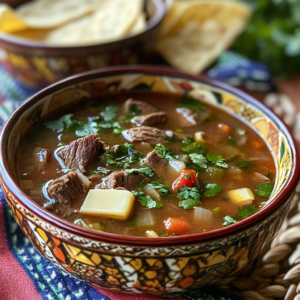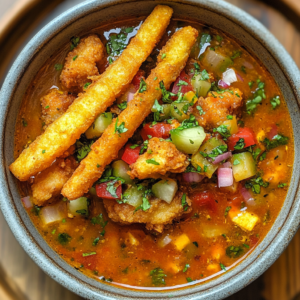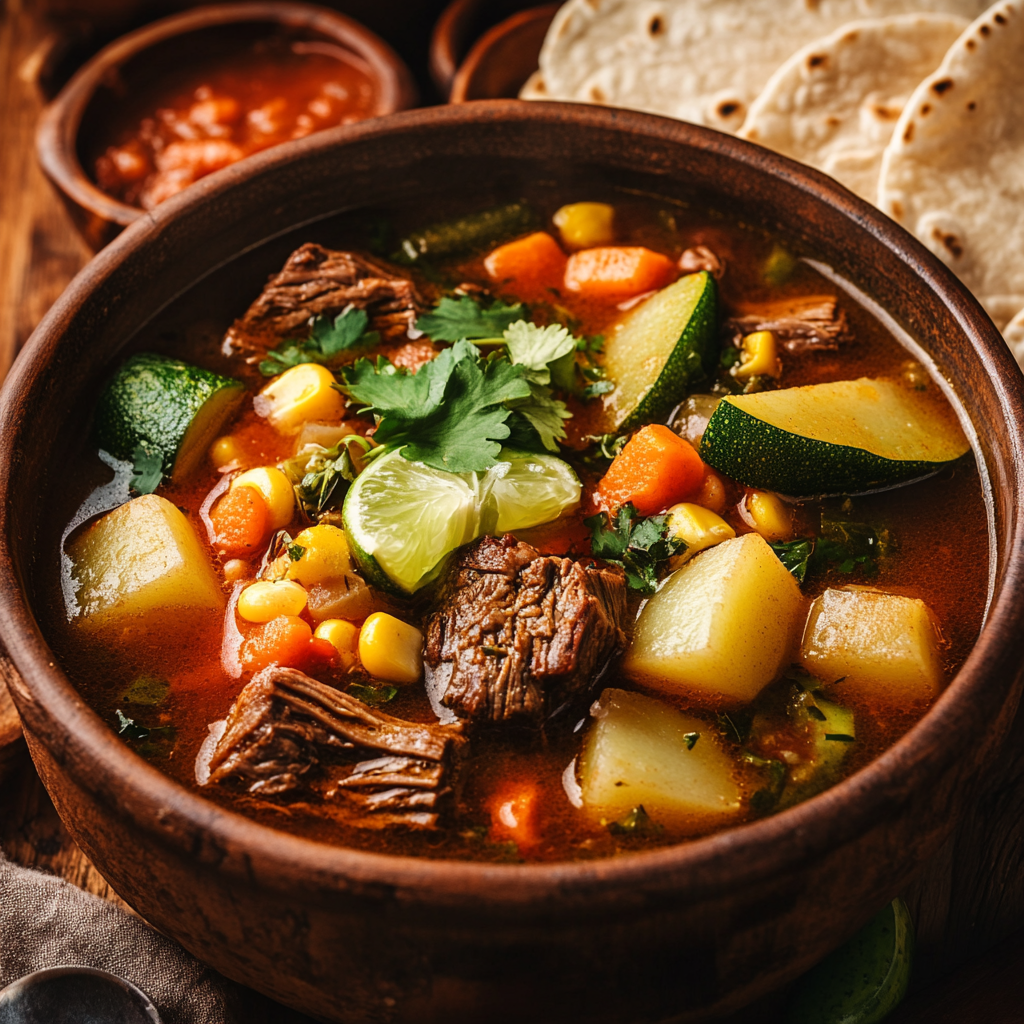If you’re craving a comforting, nourishing meal, the caldo de res recipe is a must-try. Known for its rich broth and tender beef, this traditional Mexican beef soup is packed with hearty vegetables and vibrant flavors. Whether you’re new to Mexican cuisine or a seasoned home cook, making caldo de res is simpler than you might think. In this guide, we’ll walk you through everything from choosing the right ingredients to perfecting the cooking technique.
Why You Should Try Caldo de Res
There are many reasons why the caldo de res recipe remains a staple in Mexican households:
- Nourishing and Hearty: It’s filled with nutrient-rich vegetables and slow-cooked beef for a wholesome meal.
- Simple Ingredients: Most of the ingredients are affordable and easy to find in any grocery store.
- Versatile: You can customize the vegetables and spices to your liking.
- Comfort Food: The warm broth makes it perfect for cold days or when you need something soothing.
Tools and Equipment for Making Caldo de Res
Having the right equipment makes cooking caldo de res even easier. Here are a few essentials to ensure success:
- Large Stockpot: A big pot is necessary to accommodate the beef, broth, and vegetables.
- Cutting Board and Knife: For chopping vegetables and cutting beef into portions.
- Slotted Spoon: Useful for skimming off impurities during the simmering process.
- Ladle: Essential for serving the soup neatly into bowls.
- Serving Bowls: Wide bowls are perfect for enjoying every element of this hearty soup.
History of Caldo de Res
Caldo de res, which translates to “beef soup,” has roots in traditional Mexican cuisine. The dish originated as a way to use inexpensive cuts of beef and seasonal vegetables to create a filling, nutritious meal. Over generations, families have adapted the recipe to include regional vegetables like zucchini, corn, and potatoes. Today, caldo de res is a symbol of comfort and community, often served at family gatherings, holidays, and celebrations.
Regional Variations of Caldo de Res
While the traditional caldo de res recipe remains consistent across Mexico, there are slight regional variations that reflect local tastes and ingredients. In northern regions, cooks often add chayote or nopales (cactus paddles) to enhance the soup’s texture. Meanwhile, coastal areas may include shrimp or fish to create a lighter seafood version.
In central Mexico, a smoky flavor is achieved by incorporating roasted tomatoes and dried chilies into the broth. In some regions, locals use beef short ribs instead of shank for a richer, fattier broth. These regional twists make caldo de res a dish that represents the diversity of Mexican cuisine. No matter where you are, each version captures the comforting essence of the original recipe.
Cultural Significance of Caldo de Res
Caldo de res holds deep cultural significance in many Mexican households. This comforting dish symbolizes warmth, togetherness, and tradition. In rural areas, families often cook it in large pots to share during festivals, holidays, and special family gatherings. Moreover, each region adds its own spin to the dish based on local ingredients, making it a true reflection of Mexico’s culinary diversity.
In some parts of Mexico, caldo de res is known as the ultimate comfort food, often prepared to help people recover from illness or long, tiring days. Its hearty ingredients, including beef bones and seasonal vegetables, make it both filling and restorative. Today, this traditional dish continues to serve as a reminder of family, home-cooked meals, and Mexican culinary heritage, bringing generations together at the table.
Ingredients for Caldo de Res Recipe

To prepare a traditional caldo de res, you’ll need the following ingredients:
- Beef Shank with Bone (2-3 lbs): The bone adds flavor to the broth.
- Water (10-12 cups): Forms the base of the soup.
- Garlic Cloves (4-5): Adds depth to the broth.
- Onion (1 large, halved): Used to infuse the broth with flavor.
- Carrots (3, cut into chunks): Adds sweetness and texture.
- Potatoes (3, quartered): Makes the soup more filling.
- Corn on the Cob (2, cut into thirds): A traditional addition for extra flavor.
- Zucchini (2, sliced): Lightens the dish.
- Cabbage (½ head, chopped): Provides crunch and flavor.
- Cilantro (¼ cup, chopped): Garnish for added freshness.
- Salt and Pepper: For seasoning to taste.
Choosing the Right Beef
Using the right cut of beef is essential for achieving the best flavor and texture in your caldo de res recipe. Beef shank with the bone is ideal because the marrow adds richness to the broth. Short ribs or oxtail are also excellent alternatives if you want a deeper, more flavorful soup.
When buying beef, look for cuts with a bit of fat and connective tissue, as these contribute to the dish’s hearty texture. Additionally, it’s important to simmer the beef slowly to allow the flavors to develop fully and ensure the meat becomes tender. For even more flavor, some cooks sear the beef before adding it to the broth, creating a caramelized base that enhances the soup’s depth.
Step-by-Step Instructions for Caldo de Res
1. Prepare the Broth
- In a large stockpot, add the beef shank, garlic, onion, and water.
- Bring the mixture to a boil, then reduce the heat to a simmer. Skim off any foam or impurities that rise to the surface.
- Cover the pot and let the broth simmer for 1.5 to 2 hours, or until the beef becomes tender.
2. Add the Vegetables
- Once the beef is tender, remove the garlic and onion from the broth.
- Add the carrots, potatoes, and corn. Continue simmering for 20-30 minutes until the vegetables start to soften.
- Finally, add the zucchini and cabbage. Cook for an additional 10-15 minutes until all vegetables are tender but not mushy.
3. Serve the Caldo de Res
- Ladle the soup into bowls, ensuring each serving has a bit of beef and a variety of vegetables.
- Garnish with chopped cilantro and a squeeze of lime juice for a burst of freshness.
- Serve with warm tortillas or Mexican rice on the side for a complete meal.
Pro Tips for Perfect Caldo de Res
- Use Bone-In Beef: The bone releases collagen, enriching the broth and giving it body.
- Season Gradually: Add salt and pepper throughout the cooking process to build layers of flavor.
- Skim the Broth Regularly: Removing impurities keeps the broth clear and enhances taste.
- Don’t Overcook the Vegetables: Add vegetables in stages to avoid them becoming too soft.
Tips for Cooking Caldo de Res for a Crowd
Cooking caldo de res for a large group requires a few adjustments. To begin with, double the amount of broth and vegetables to ensure everyone gets a generous portion. Moreover, use a larger pot or multiple smaller pots to avoid overcrowding the ingredients.
Additionally, prepare the broth ahead of time to save effort on the day of serving. When guests arrive, you can easily reheat the broth and add fresh vegetables just before serving. Meanwhile, offering a toppings bar with lime, cilantro, and salsa allows guests to customize their bowls. In this way, everyone enjoys a delicious, personalized meal. If you’re feeding a large group, consider preparing an additional dish like slow cooker beef and noodles to complement the soup.
Health Benefits of Caldo de Res
Caldo de res is not only delicious but also packed with essential nutrients. The beef provides a good source of protein and iron, which support muscle repair and prevent anemia. Bone-in cuts contribute collagen to the broth, promoting joint and skin health. Meanwhile, the variety of vegetables offers essential vitamins, fiber, and antioxidants that help boost the immune system.
The warm broth is hydrating and soothing, making this soup a popular remedy for colds or flu. Additionally, the potassium in potatoes and zucchini helps regulate fluid balance, while the cilantro garnish offers anti-inflammatory properties. Ultimately, this nourishing soup makes a great addition to a balanced diet, especially on colder days when your body craves warmth and comfort.
Topping and Serving Suggestions
One of the best things about caldo de res is how customizable it is. Here are some ideas for toppings and sides:
- Fresh Lime Wedges: Squeeze over the soup for added brightness.
- Chopped Jalapeños: For those who enjoy a bit of heat.
- Avocado Slices: Adds creaminess to each spoonful.
- Warm Tortillas: Perfect for dipping into the broth.
- Mexican Rice: A traditional side that complements the soup.
Pairing Drinks with Caldo de Res
Pairing the right drink with your caldo de res naturally elevates the dining experience. For instance, for a refreshing option, serve it with chilled agua fresca, such as horchata or hibiscus tea. In addition, these drinks complement the soup’s warmth with their sweet and fruity flavors. Alternatively, a light Mexican lager provides a crisp contrast to the hearty broth.

If you prefer non-alcoholic options, try a cold cucumber-lime drink or sparkling water with a squeeze of lime. During colder months, a cup of Mexican hot chocolate adds a cozy finish to the meal. Ultimately, no matter the drink, these pairings enhance the enjoyment of this comforting soup. Pair your caldo de res with crispy chicken fries for a delicious and unexpected combination.
Caldo de Res Variations to Try
Additionally, if you want to experiment with the classic caldo de res recipe, here are some variations to consider:
- Caldo de Pollo: Replace the beef with chicken for a lighter version.
- Spicy Caldo de Res: Add chipotle peppers or cayenne to give the broth some kick.
- Vegetarian Caldo: Use vegetable broth and add beans for protein.
- Seafood Caldo: Swap the beef for shrimp or fish for a coastal twist.
Common Mistakes to Avoid When Making Caldo de Res
Even experienced cooks can make mistakes. Here’s what to avoid:
- Boiling Instead of Simmering: Simmering ensures the broth remains clear and flavorful.
- Overcooking the Vegetables: Add them in stages to maintain texture.
- Skipping the Skimming Step: This can leave the broth cloudy and greasy.
- Undersalting: Taste throughout the cooking process to adjust seasoning as needed.
Storage and Reheating Tips
In fact, caldo de res tastes even better the next day! Here’s how to store and reheat it:
- Refrigerate: Store the soup in an airtight container for up to 4 days.
- Freeze: Freeze in individual portions for up to 3 months.
- Reheat: Warm the soup over low heat to prevent overcooking the vegetables.
How to Store and Reheat Caldo de Res
When storing leftovers, it’s best to separate the broth from the vegetables to maintain their texture. Store them in airtight containers in the refrigerator for up to 4 days. For longer storage, freeze the broth and vegetables in separate portions. When reheating, warm the broth first and then add the vegetables back in to prevent them from becoming mushy. If you’ve frozen the soup, thaw it overnight in the refrigerator before reheating. Adding fresh cilantro or lime juice just before serving will revive the flavors and give the soup a freshly made taste.
How to Use Leftover Caldo de Res
Leftovers from caldo de res offer plenty of opportunities for new dishes. The broth can serve as a base for other soups, such as a quick tortilla soup with shredded chicken and crispy tortilla strips. You can also transform leftover beef into delicious tacos or burritos by shredding the meat and adding salsa, onions, and cilantro.
Another creative idea is to blend the broth with cooked vegetables to create a smooth, flavorful vegetable soup. If you prefer something heartier, the broth can be reduced into a sauce and poured over rice for a quick meal. By repurposing leftovers, you minimize waste while enjoying a variety of meals from one recipe. Looking for another creative way to use leftovers? Try these delicious cottage cheese wraps for a quick, nutritious meal.
Frequently Asked Questions (FAQs)
1. What cut of beef works best for caldo de res?
Beef shank with bone is the best option, but short ribs also work well.
2. Can I make this soup in an Instant Pot?
Yes, use the pressure cook setting for 30 minutes and release pressure naturally.
3. What other vegetables can I add?
For example, you can add chayote, green beans, or squash for extra variety.
4. Can I freeze caldo de res?
Of course, just make sure to store it in airtight containers and reheat gently.
Conclusion
The caldo de res recipe is a comforting, nourishing dish that’s perfect for any occasion. In fact, whether you’re serving it for a family dinner or preparing it in advance for busy weeknights, this hearty soup never disappoints. By carefully following the steps in this guide, you’ll achieve a flavorful broth, tender beef, and perfectly cooked vegetables every time. Additionally, with endless variations and topping options, caldo de res is a dish you’ll return to again and again. So, enjoy preparing, sharing, and savoring this delicious traditional Mexican soup!
